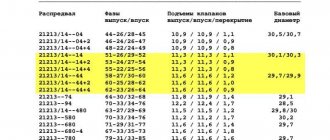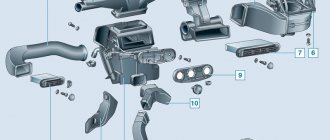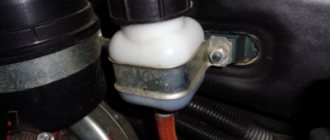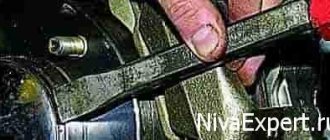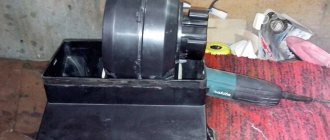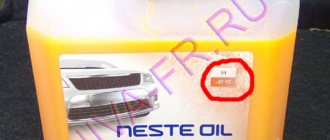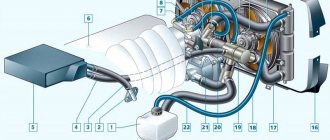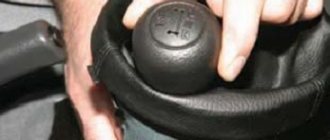When to replace a Chevrolet Niva radiator
Replacing the cooling system or its individual components is usually required due to wear or mechanical damage. Among the most common complaints when contacting a service station, the following points stand out.
- Using low-quality antifreeze or pouring water into the system. The main property of coolants is the protection of metal parts from corrosion and rust formation. When water is used in a radiator, strong carbon deposits or oxides form inside the lines, which can clog thin tubes. In case of mild damage, repair is limited to sealing one part of the system.
- Mechanical damage. The main radiator is located at the front of the car and is covered with a thin grille. Due to poor protection when traveling off-road or on country roads, the element can be damaged by a stray stone or foreign objects entering the radiator grille. At the same time, a small force is enough to cause serious damage - the thinnest plates are easily crushed, which leads to loss of heat transfer and overheating of the system.
- Natural wear and tear. During active use, the radiator is subject to constant temperature changes, which affects the condition of the metals. Additionally, the presence of increased pressure inside the lines after starting the machine is harmful. Such vibrations lead to cracking of tubes, fasteners or cooling plates.
The above cases apply not only to the main radiator; problems also arise with the elements of the stove and air conditioner.
Do-it-yourself replacement of a Niva Chevrolet radiator with and without air conditioning
If you need to replace units, you can contact a service station or a qualified technician for help. Other users prefer to perform all procedures themselves. This is possible due to the fact that replacing a Chevrolet Niva radiator pipe or the cooler itself does not require specialized tools or deep knowledge of mechanics.
Chevrolet Niva heater radiator replacement: necessary tool
To completely replace the device, you will need to prepare the necessary tools in advance.
- A set of open-end and ring wrenches, possibly heads with a knob.
- A canister of coolant of the type that was previously used in the machine system. The standard system uses 5 liters of antifreeze with a class of at least G12.
- One liter canister of power steering fluid.
- 5-6 metal clamps of the appropriate diameter, you can use plastic ones.
- A set of containers where the old antifreeze will be drained, and a funnel to make it easier to fill in the new coolant.
- Silicone sealant is resistant to high temperatures.
- Set of screwdrivers of different sizes.
- Several clean rags and gloves.
After preparing everything you need, you can begin repairing the car.
Replacing a Niva Chevrolet radiator without air conditioning: sequence of actions
The sequence of actions for cars with and without air conditioning is slightly different. Further instructions are relevant for the more common modification, which uses a conventional stove.
- Drive the car onto an overpass or inspection hole. After this, wait the certain time necessary for the engine to cool completely. This is required because the antifreeze gets very hot during operation and performing a hot repair procedure can lead to serious burns or damage to vehicle components.
- Place wheel chocks under the wheels, raise the handbrake lever and engage the gear. During manipulations, the car will constantly twitch - unnecessary movements will not bring anything good.
- Open the hood and disconnect the terminals from the battery - the need is caused by tampering with the electrical part of the car.
- If necessary, remove the crankcase protection and outer plastic (if any) - this will facilitate access to the required fasteners and components.
- Treat all bolted connections with a liquid wrench or similar means to facilitate their unscrewing. In this case, you should not use a hammer or chisel - an entrenching tool can only cause harm - only keys will be used here.
- The next stage is disassembling the decorative radiator grille. The body part is removed using a Phillips screwdriver and a No. 10 socket.
- Next, two mudguards under the engine are removed. Dismantling can also be done with keys or a screwdriver.
- After opening access to all systems, the antifreeze is drained. To do this, you will need to fully open the valve of the stove and auxiliary devices where the coolant flows. After identifying the tap, you should wear protective gloves and goggles - the formula in the radiator is toxic and can cause severe poisoning if it gets into the stomach or eyes. Next, you will need to unscrew the top cap of the expansion tank to facilitate fluid drainage. The next step is to crawl under the car and find the drain valve on the left side of the radiator and open it. You will first need to place a canister or container under the used product (the capacity must be at least 5 liters). After this, the used antifreeze is disposed of appropriately.
- Wait until the refrigerant has completely drained and tighten the valve until it stops.
- Then, to replace the Niva Chevrolet cooling radiator, you should again rise above the car and remove the air filter box. The fasteners are made in the form of 4 bolts with No. 10 heads.
- Next, unscrew the pipes entering and exiting the radiator. The lines are secured with metal clamps and loosened with a Phillips screwdriver.
- Next, remove the top cover of the power steering expansion tank.
- Disconnect the pipes coming from the power steering to the cooling system, first placing an empty container under the connections for testing.
- Similarly, disconnect the lower hoses using one sequence of actions.
- The next step is to disconnect the radiator itself. The part is secured with 5 bolts, one of which is screwed in through a special bracket; it can also be disassembled.
- Drain the remaining antifreeze from the radiator (there will be about one liter).
- Next, you need to disconnect the contact groups of the horn and radiator fans. If this is not done, the wiring will interfere with dismantling.
- Remove the horn using screwdrivers and wrenches.
- After this, you need to disconnect the line on the thermostat, leaving the latter on the tube along with the engine.
- Repairs are ongoing by removing the fly catcher and small stones. The part is placed directly in front of the radiator and secured with 4 bolts and nuts.
- Next, remove the part holders and move the upper part of the radiator forward in the direction of travel of the car.
- Next, unscrew and tighten the pressure line hoses, this is also done carefully; there may be some antifreeze residue inside.
- To continue dismantling, you need to separate the radiator body from the fan module. To do this, unscrew 6 screws. The first 4 are located in the upper part, the lower two require a special approach and are located at the bottom of the unit.
- After all the manipulations, the modules are separated and the coolers are lifted up.
- Next, the lower pipe is removed and the air trap is bent. The last element is covered by a bumper, so it will also need to be unscrewed.
- After completing all the steps, the old radiator is completely removed from the engine compartment along with the support rubber bands and pads (they may come in handy).
- Reassembly is performed in the reverse order, adding antifreeze. After complete installation of the system, the motor warms up and the coolant is added if necessary.
- Replacement of the Niva Chevrolet cooling radiator without air conditioning has been completed.
When does a radiator need to be replaced?
If the system is sealed, the coolant level does not change; it will always be at the same level. During engine operation, due to heating and expansion, the mark will rise slightly, but upon cooling it will return to its original position.
A case from practice: a fluid level above normal may be due to an air lock. This often happens when the filling of antifreeze or antifreeze is disrupted during repair work.
Often, due to damage to the radiator, the coolant level drops.
A malfunction can be detected by the following signs:
- the appearance of a leak on the front surface of the bumper;
- smudges under the car near the right or left headlight;
- a drop in the level of antifreeze or antifreeze and “fogging” on the surface of the radiator.
If at least one of the signs is detected, the radiator must be replaced. If repair work is not carried out in time, the leak may worsen and the car will be unusable. The repair is quite simple; you can do it yourself even without professional skills. Algorithm for replacing a radiator Most often, the radiator is replaced when a leak appears that cannot be eliminated with conventional sealant. The manufacturer recommends installing only original parts that exactly fit in size and fit. Note: together with the radiator, you can also change the cooling fans by disconnecting them from the network and unscrewing the fasteners from the cases. Replacing the radiator of a Niva Chevrolet - work algorithm: 1. Remove the negative terminal from the battery. 2.Remove the crankcase protection and mudguard by unscrewing the fasteners.
3.Unscrew the coolant drain plug, having first unscrewed the cap of the expansion tank and switched the damper to “hot air”.
4.Remove the decorative radiator trim.
5.Disconnect the terminals from the cooling fans.
6. Unscrew the top and side bolts securing the upper casing and remove it.
7. Remove the lower casing in the same way.
8. Remove the lower hose from the thermostat by unscrewing its clamp. Carefully pry off the pipe with a screwdriver and do not tear it.
9. Unscrew the upper radiator mounting brackets and remove them.
10. Pull the radiator towards you and remove the return hose.
11. Disconnect the bolts securing the electric fan housing and pull the radiator towards you to gain access to the lower pipe. Loosen its clamp and remove the hose.
12. Carefully remove the radiator.
Assembly is carried out in the reverse order of removal. If you are going to change the fans, remove their nuts from the housing. When tightening, do not overdo it; with too much force, the plastic may burst.
Note: if you don’t remember when you changed the coolant, it’s better to fill it with new one. It is not advisable to filter old antifreeze or antifreeze, which already contains debris and dirt.
Replacing the Chevrolet Niva heater radiator
The specified sequence of actions is relevant for car models without an air conditioning system.
- Completely dismantle the glove box along with its lighting and brackets. To do this, you will also need to disconnect the side trim elements of the interior.
- Drain the antifreeze from the car's cooling system.
- Loosen the connections of the pipes and tighten them. In this case, antifreeze will flow from the channels - you need to substitute a piece of plastic bottle or a tray in advance.
- Next, unscrew the heat exchanger screws and pull the part towards you until it stops.
- Interfering structural elements can be removed or, for plastic elements, bitten off with tongs.
- After which the part will freely leave the seat.
Installation of a new device is carried out in the reverse order, fully observing the instructions and sequence of actions.
Replacement radiator Niva Chevrolet price
The cost of such car repairs in different regions can vary significantly. For example, in Moscow, replacing a radiator will cost at least 5,000-8,000 rubles. At the same time, in the Rostov region, the procedure can be performed for 3-4 thousand rubles. At the same time, the cost of repairs may also vary among different specialists located in the same city.
Also, the cost of replacing a Niva Chevrolet radiator greatly depends on the vehicle’s equipment and additional factors such as the abundance of rust or dirt under the hood. For example, the difference between the simplest and most sophisticated versions can reach 1,500 rubles.
Only the master performing the operation can give the exact price tag.
Comparison of manufacturers
In stores you can find spare parts produced by several companies. Products differ in two parameters: price and workmanship. Let's look at a few of the most popular brands.
Hola is a trademark of the Dutch company H{amp}amp;H Group. 15 European factories produce radiators, belts, shock absorbers and other auto parts. Inexpensive products of this brand are of good quality. According to customer reviews, spare parts of this brand at a comparable price are superior in quality to Chinese products. Price - 2000 rubles.
DAAZ - Dmitrov Automotive Assembly Plant, part of the United Automotive Technologies concern, was founded back in 1967. In addition to radiators, the company produces filters, brake pads and other spare parts for Russian and foreign cars. The products of this brand are used in cars that come off the AvtoVAZ assembly line. Price - 2500 rubles.
Luzar is a Russian company that was founded in 2003 on the basis of the Lugansk Radiator Plant. Products of this brand comply with GOST-R and the manufacturer gives them a 2-year warranty. Price - from 2100 rubles.
Bautler is a British company that produces, among other things, spare parts for the Chevrolet Niva. Price - from 2200 rubles.
Reviews from car owners vary. Some consider DAAZ radiators to be the most reliable, others consider Bautler, Hola or Luzar.
Taking into account the fact that replacing a part takes a lot of time and effort, it is worth taking the sports version of Luzar. It is designed to withstand heavy loads and is therefore more reliable.
Also interesting: Transfer case Niva - Device - Lada master
Hola products are distinguished by the fact that each tube has its own rubber seal, rather than being fixed with a single seal. In Luzar-Sport, the honeycomb is soldered to a base that is attached to the tanks.

